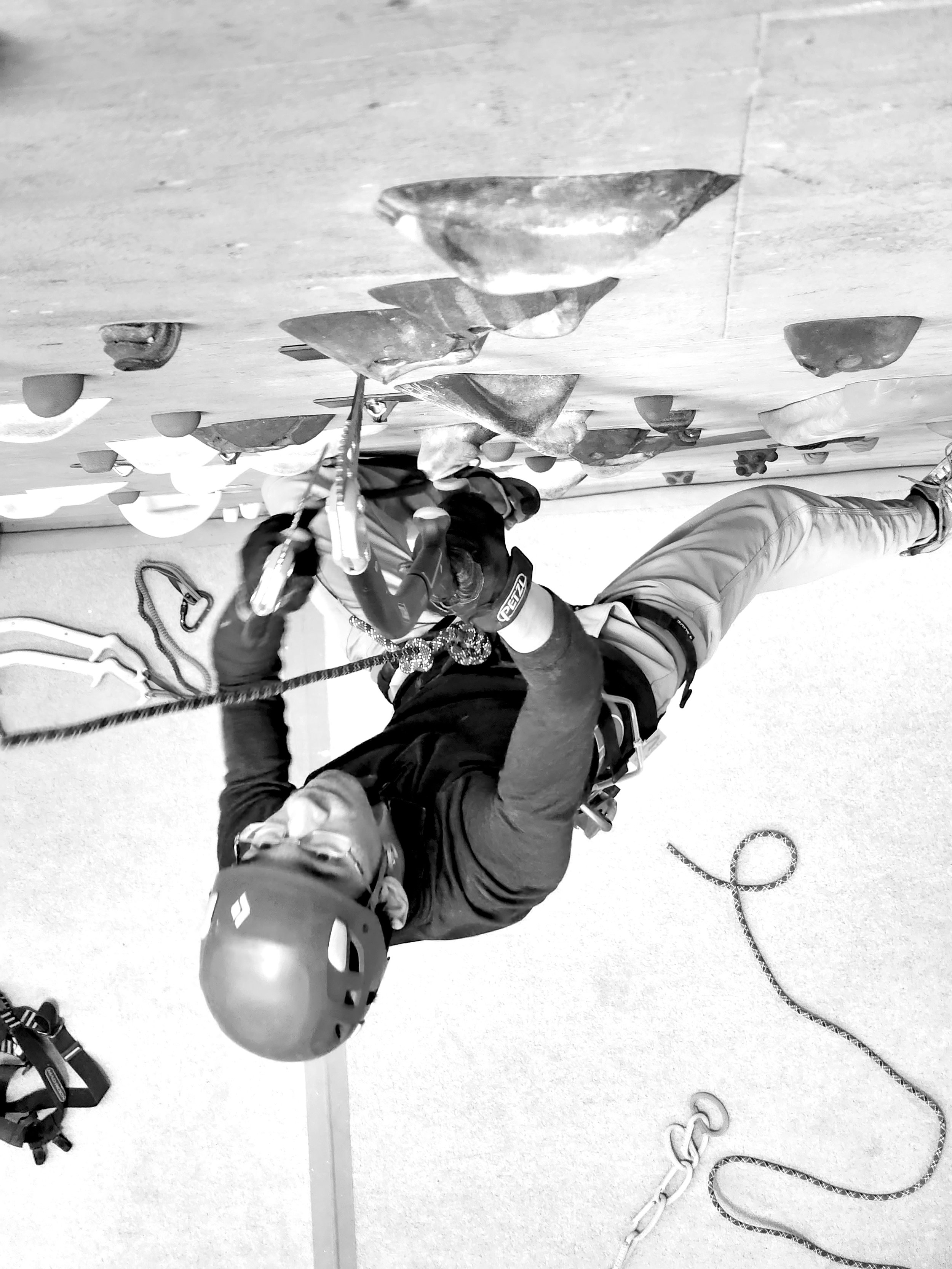Ice climbing, drytooling, and mixed climbing can be expensive activities to get into. Add in the cost of training gear to get ready for those activities and that’s pushing costs deep into $1000’s. If you have your own home wall and you are looking to add some training with your ice tools to your regimen without pushing your credit cards to their limits, there are some old school solutions, each one with advantages and disadvantages to help you get there.
Note: what we’re really talking about here is drytooling. This will not train your swing, but it will train just about everything else. Swinging ice tools indoors is just a bad idea. Stick with drytooling moves for safety and less potential damage to you and your wall.
There are indeed excellent, manufactured holds readily available. What they provide is convenient access to durable, purpose-built drytooling holds designed to get you ready for the outdoors. But, like that foothold on that eliminate boulder problem, you don’t have to use those holds. Let’s see what else is out there:
Click HERE to check out the full line of Drytooling Holds available from Furnace Industries
Door hinges
Cheap, durable, and great for training placement accuracy, door hinges have been one of the 4 pillars of drytooling training since some crackpot decided to use their tools inside. They are cheap, kinda strong, and will last a long time. With some creativity, you can set really creative and challenging moves like gastons, side pulls, and even stein pulls. Be careful with the stein pulls though. Those can be dangerous even after you’ve tested it six ways from Sunday. Why? Because hinges are meant to hang doors. They were not designed as drytooling holds.
-For the primary placement, pull the hinge pin out and use one of the circular portions left by the pin. Mount the hinge on a backer plate and get training.
-If you’re feeling lucky, use the edge. That’s gonna be hard and slippery placement, but maybe that’s what you want.
-Mount them with the countersink facing the wall for a very shallow pick placement. Laser focus on consistent body positioning will be the only thing keeping you on.
-Leave the pin in the hinge and use the outer leaf as a bridge-style placement. These are very effective, but beware of bending the leaf under weight. Remember, these are meant to hang doors, usually with two or three other hinges. They were not designed to be used as drytooling holds.
Wood Blocks
The second pillar of the DIY drytooler, blocks of wood can be very effective. Wood can be great as it’’s low cost and easy to work with. There variations are endless. Here is just one method:
-Cut a 2x4 into 4” blocks, then, safely using the right tools, cut and angle into the top edge. The more incut the angle the steeper the terrain you can use it on. Think of creating a jug for your hand, ‘cept you’re using ice tools. Unless you’re screwing the wood directly to the wall, drill a 3”8” hole in the wood and voilá, drytooling hold. Use a washer on the bolt head to prolong the life of the mount and make sure to put in a spinner screw. There‘s some great info on making wood climbing holds, not necessarily drytooling holds but you’ll get the idea, here.
However, wood will degrade over time and abuse. Wood will splinter after repeated pick placements. Wood holds will become brittle and worse, unpredictable. You don’t want to get hurt while training when a hold breaks unexpectedly.. You can’t really crank them down on the bolt either or you’ll break them. Even if you choose to screw them on, they can, or rather will, eventually split.
Moulding and Vinyl
Falling somewhat under the wood blocks category, some DIY drytoolers have used short lengths of scrap mouiding screwed to the wall as drytooling holds. Best of all, you can probably get these for free as samples from decking material companies. The important thing here is to use hardwood, or even vinyl, that has a positive top edge.
-AZEK, a material used in vinyl siding and outdoor decking can be cut into shapes making for great drytooling fun. If you or someone you know, or someone on craigslist, has recently reno’d their deck, snag some lengths, cut em, drill, em, climb on em. Bonus, you could pick a tone that matches your personal temperament. I’m more of a Mahogany guy…
AZEK Decking
Rocks
Using real stone makes up the third pillar of DIY drytooling. These are my favorite as I was a geology minor and I get to geek out about material makeup and such. Really tho, these are awesome because they last a really long time, mimic real drytooling moves, and they just look cool.
They do take bit of work to get them just right however. Invest in a good set of eye and ear protection, a good, variable speed corded drill, something beefy to hold the rock in place (unlike in the video, where you expect that guy to lose a finger). and some drill bits. Ideally all you’re doing is drilling a hole, but if more stonework is needed, you may as well buy ready made stone holds as the equipment needed (stone cutting tools, diamond tipped bits, a rotary press bench drill, with vise, some method for water cooling so you don’t foul the bits, time) will become cost prohibitive very quickly.
Make your own Resin or Polyurethane Holds
The technology for casting resin or polyurethane climbing holds is not a secret. At this point in the internet age, there are many, many YouTube videos on the subject. It’s work, but it’s not hard work. If you have the time and inclination, it can be a very rewarding process. But if you have too many things going on, it’ll be a messy, total waste of time and money that is never ever completed. AND, remember you’re trying to make drytooling holds, so you have to make sure you get the mix right so the holds are hard enough to withstand ice and mixed picks. There’s a lot of trial and error, but if you never got over your mom tossing your chemistry kit, this may be a good way to go.
Logs
Logs. Yes, big monster logs. Many ice climbers and drytoolers have been successful at installing large hanging logs or structures that they drill holes into and then spray paint around the holes to specify placements. When hung horizontally these setups allow for sick Fig 4/9 traverses.
This idea can easily apply to any structural material like 2x6’s and 4x4 fence posts. Use your imagination, but use EXTREME CAUTION as to how it’s rigged. Imagine the whole thing falling with you on it?
Here’s a ladder setup with thoughtfully rigged obstacles. Kinda awesome right?:
Other Methods
The ‘other’ is the 4th pillar. Get creative. Like any good alpine climber, drytoolers have become quite resourceful in their quest to be cheap (and yet at the same time spend almost $1000 on their ice gear) If you can hook it, torque it, bolt/screw it to a wall, and it’s even somewhat durable, it might well be a drytooling hold. Here are some of the more creative finds:
Chain
Lengths of chain hung from steep or overhung walls make for crazy fun and difficult training. Is it training for anything real? Perhaps not, but the beneficial core work alone is worth the effort. If you can stabilize on a swinging chain, think what you could do if the medium was frozen in place!
Hockey Pucks
Hockey pucks were and still are a great option for the DIY drytooler. This is because they are cheap, hard but not too hard, and easy to cut. You can make actual shapes from the puck. Picks dig right in, but after a time, they will wear and need replacement. Here is a nice vid of making holds from hockey pucks:
Archery Target Foam
The 6lbs density polyethylene foam used in archery targets just happens to be dense enough to hold the weight of a climber with a pick sunk into it, mostly. $25 for a 2”x23”x24”at FoambyMail.com. Glue 2-3 layers of this to a wood backer plate then mount to your wall and swing away! Your training will be on target before you know it. Just use extreme caution swinging tools indoors…
Angle Iron
Saving the best for last, this is one of my personal favs. Two lengths of heavy duty angle iron mounted just right can create a pretty sweet crack for picks to engage. It’s haaaaard, but great training that inspires creative movement and keen awareness of footwork, body positioning and body tension. A bit worky on the outset to cut to lengths and drill holes in the right places, but once you get it installed on your wall it’s game on!
-bc




